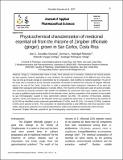Mostrar el registro sencillo del ítem
Physicochemical characterization of medicinal essential oil from the rizome of Zingiber officinale (ginger), grown in San Carlos, Costa Rica
| dc.creator | González Guevara, Jean Carlo | |
| dc.creator | Madrigal Redondo, German | |
| dc.creator | Vargas Zúñiga, Rolando | |
| dc.creator | Rodríguez Sibaja, Santiago | |
| dc.date.accessioned | 2019-03-22T20:40:48Z | |
| dc.date.available | 2019-03-22T20:40:48Z | |
| dc.date.issued | 2017 | |
| dc.identifier.citation | http://docs.wixstatic.com/ugd/e6f2ee_73727dca37bc4eeaa2ec5c3458ff5fb4.pdf | |
| dc.identifier.issn | 2358-3495 | |
| dc.identifier.uri | https://hdl.handle.net/10669/76754 | |
| dc.description.abstract | Ginger is a medicinal plant native to India. Their potential use in cosmetics, medicines and natural productshas been reported, however depending on crop conditions,the medicinal components of the different parts of the plantmaynot only go through changes in concentration but in composition, what modifies its medicinal potential. The aim of this study was to characterizeby the chemical composition of essential oil obtained from rhizomes of Zingiber officinalegrown in the area of San Carlos, Costa Rica,in order to standardize future hydroponic cultivations of the plant and validate their subsequent pharmacological or cosmetic effects.The rhizomes of the plant were used, the active principles were extracted by ethanolic extraction with Soxleth and distillation by entrainment with vapor, analysis was performed by using a qualitative phytochemical profile for the ethanolic extract, and the composition of the essential oil was studied by gas chromatography coupled to mass spectrometry detector (GC-MS). Thepresence of flavonoids, alkaloids, saponins, tannins and triterpenes in the ethanolic extract was qualitatively determined. In characterizing the essential oil by GC-MS we identified as lead compounds geranialdehyde (27.42%), neral (20.11%), 1.8-cineole (13.35%), camphene (4.65%) and E-geraniol (3.92%). The composition we obtained presenteda clear difference with those reported in other studies, allowing the prediction of an antimicrobial behavior unlike most traditional essential oils of the rhizomes. | es_ES |
| dc.description.sponsorship | Universidad Nacional de Costa Rica/[]/UNA/Costa Rica | es_ES |
| dc.description.sponsorship | Universidad de Costa Rica/[]/UCR/Costa Rica | es_ES |
| dc.language.iso | en_US | es_ES |
| dc.rights | Atribución-NoComercial-CompartirIgual 4.0 Internacional | * |
| dc.rights.uri | http://creativecommons.org/licenses/by-nc-sa/4.0/ | * |
| dc.source | Journal of Applied Pharmaceutical Sciences, vol.4(1),pp.9-18 | es_ES |
| dc.subject | Zingiber officinale | es_ES |
| dc.subject | Essential oil | es_ES |
| dc.subject | Gas chromatography | es_ES |
| dc.subject | Natural product | es_ES |
| dc.subject | Antimicrobial | es_ES |
| dc.title | Physicochemical characterization of medicinal essential oil from the rizome of Zingiber officinale (ginger), grown in San Carlos, Costa Rica | es_ES |
| dc.type | artículo original | |
| dc.description.procedence | UCR::Vicerrectoría de Investigación::Unidades de Investigación::Ciencias de la Salud::Instituto de Investigaciones Farmacéuticas (INIFAR) | es_ES |
Ficheros en el ítem
Este ítem aparece en la(s) siguiente(s) colección(ones)
-
Farmacia [180]



